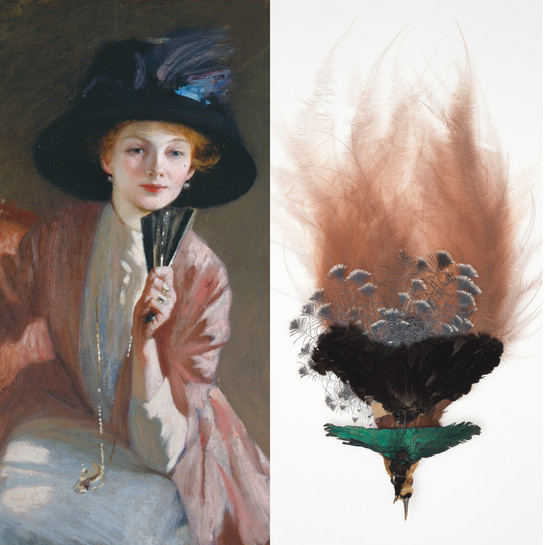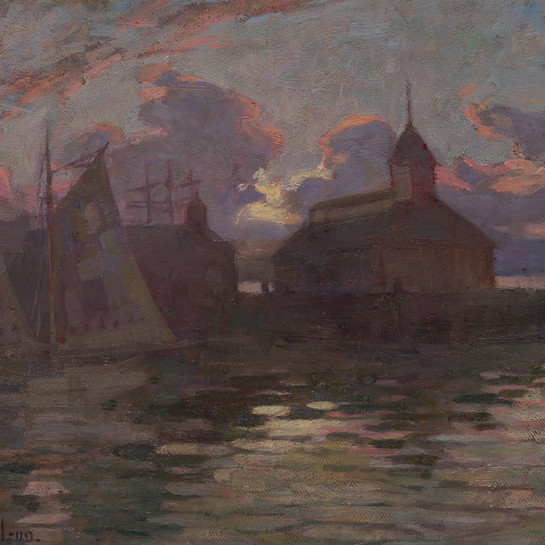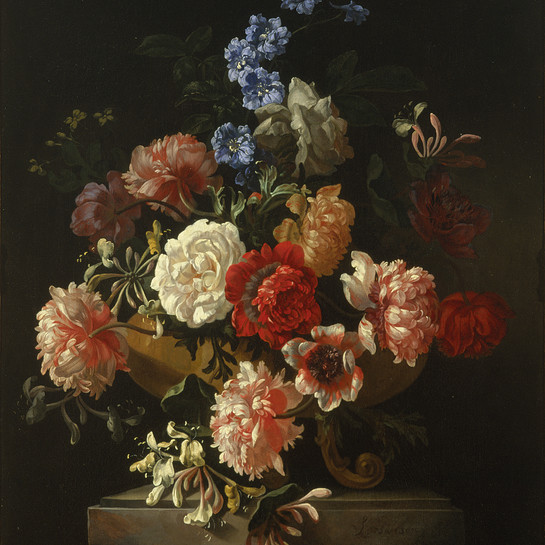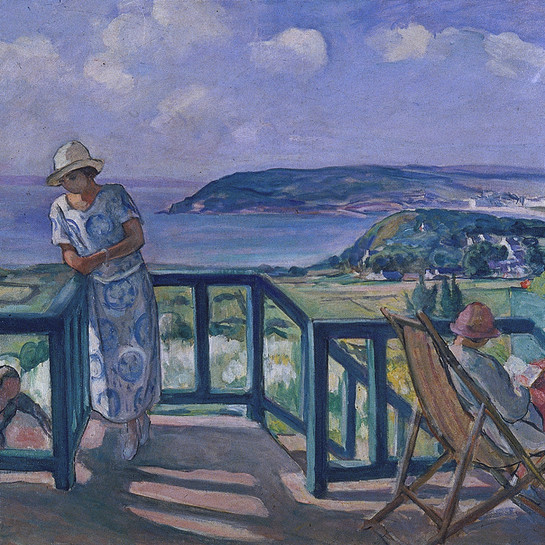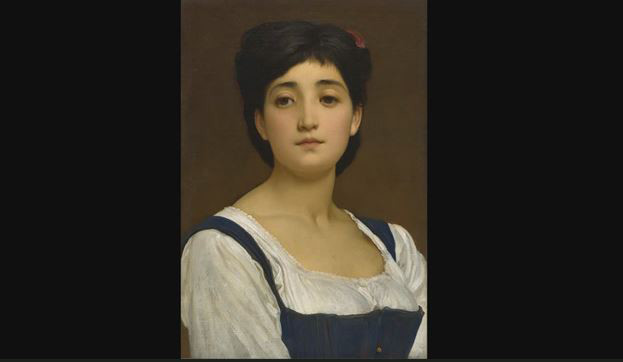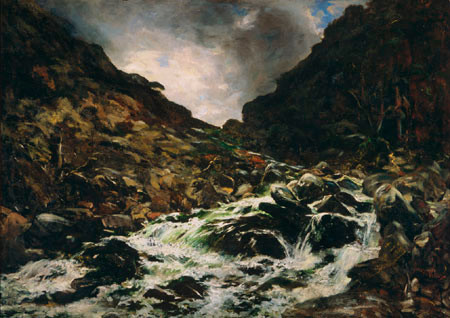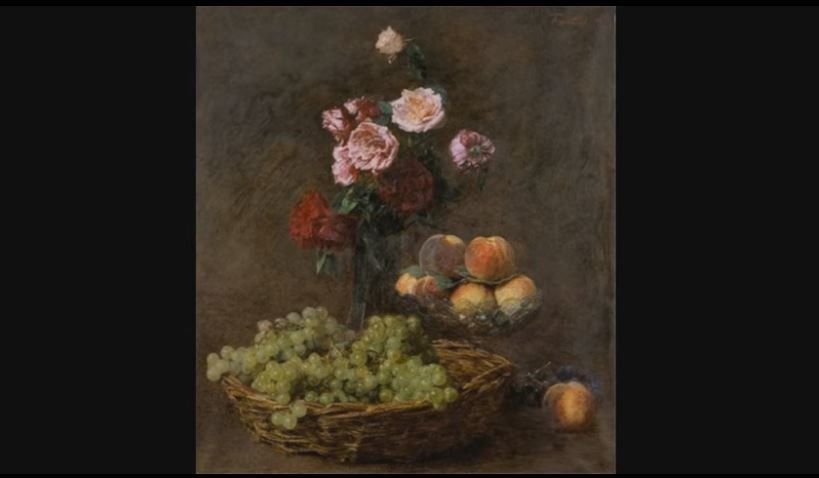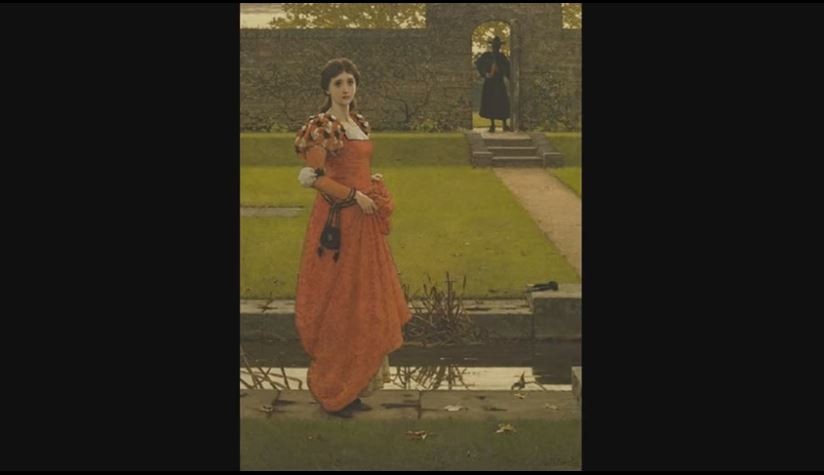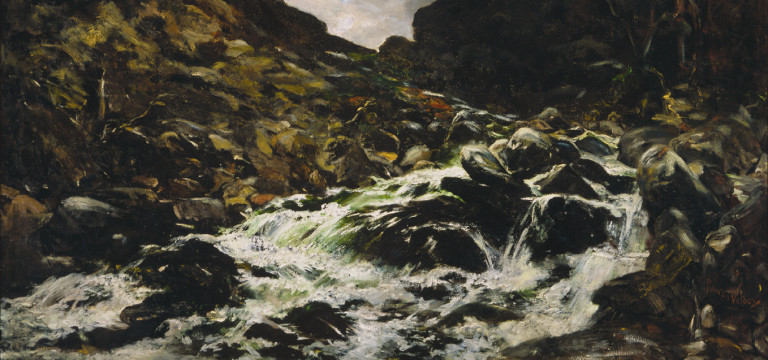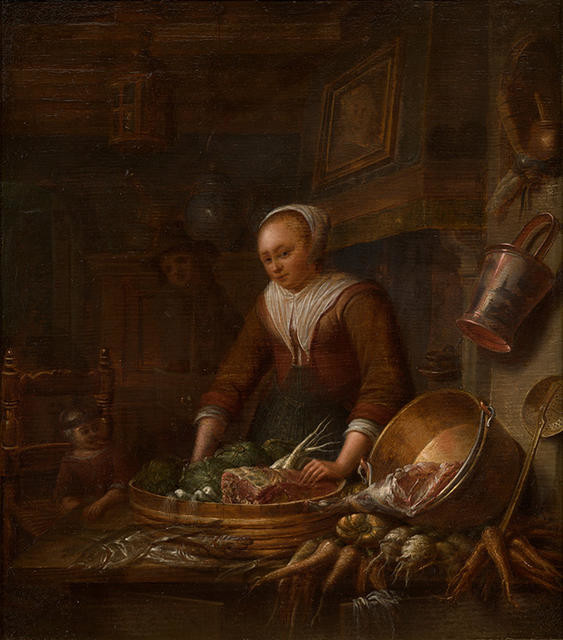Gottfried Lindauer
b.1839, d.1926
Ana Reupene Whetuki and Child (Ngāti Maru) [also known as Heeni Hirini and Heeni Phillips]
- 1880
- Oil on canvas
- Presented by the family of Mr and Mrs B Ballin, 1936
- 1025 x 885 x 90mm
- 69/93
Tags: cloaks, double portraits, earrings (jewelry), infants, jades (objects), jewelry, korowai, koru (pattern), Māori (culture or style), moko, mothers, people (agents), pounamu, spirals (geometric figures), tattoos, women (female humans)
Ana Reupene Whetuki, also known as Heeni Hirini and Heeni Phillips, belonged to the Ngāti Maru iwi, based in the fertile Hauraki region of Te Ika-a-Māui the North Island. During the 1850s the tribe’s small kainga (settlement) provided large supplies of food to the new capital of Auckland. When gold was discovered near Thames, however, European miners flooded in, rapidly establishing a town of 40,000 people. Mining, and later logging and pastoral farming, led to the destruction of traditional Māori food sources. This portrait is one of many Gottfried Lindauer painted of Reupene and her pēpi (baby), all based on a studio photograph taken by the Foy Brothers of Thames. Her son, carried close on her back in keeping with Māori custom, is remembered within Ngāti Maru for his skill in reciting whakapapa (ancestral connections). He is believed to have died in his late teens.
Ship Nails and Tail Feathers, 10 June – 22 October 2023
Exhibition History

Te Wheke: Pathways Across Oceania, 30 May 2020 – 3 July 2022
Ana Reupene Whetuki from the Ngāti Maru iwi (tribe) was well-known in the Thames goldfield district in the Coromandel. Also known as Heeni Hirini and Heeni Phillips, she married the Ngāti Maru rangatira (chief) Reupene Whetuki and lived at Manaia, where some of her descendants still live today.Gottfried Lindauer based this portrait on a striking 1870s photographic studio portrait by the Foy Brothers of Thames. Lindauer first visited Thames in 1874, shortly after arriving in Aotearoa New Zealand from Bohemia (present day Czech Republic). He painted at least twelve versions of this portrait between 1878 and 1920.
He Waka Eke Noa, 18 February 2017 – 18 February 2018
Ana Reupene Whetuki from the Ngāti Maru iwi (tribe) was well- known in the Thames goldfields district in the Coromandel. She lived at Manaia, where her descendants still live today. Also known as Heeni Hirini and Ana Rupene, she was married to Reupene Whetuki, a Ngāti Maru rangatira (chief) who in 1881 was also listed as a gold miner and shareholder in ‘The Maori Win Gold Mining Company’. Gottfried Lindauer is known to have painted at least twelve versions of this portrait between 1878 and 1920. These were based on the photographic studio portrait by the Foy Brothers of Thames, which is also in this exhibition. Lindauer had first visited Thames in 1874 shortly after arriving in New Zealand from Bohemia (present day Czech Republic).
Treasury: A Generous Legacy, 18 December 2015 – 27 November 2016
Ana Reupene Whetuki was a well-known face in the 1870s Coromandel goldfield town of Thames, and has many descendants. Gottfried Lindauer's portrait is based on a photograph by the Foy Brothers of Thames. Lindauer visited Thames not long after his arrival in New Zealand from Bohemia (present day Czech Republic) in 1874.
This 1880 portrait was given to the city's new gallery in 1936 by the family of the Jewish, German-born Bernhard H Ballin (1848-1931) and his wife Clara. Ballin and two brothers were cordial manufacturers in Thames from 1872 until 1878, when he relocated to Christchurch to establish his aerated water company.
Belonging to Ngati Maru of the Hauraki District, Ana Reupene Whetuki is said to have been a well-known identity in the goldfield town of Thames in the 1870s. Painted in a highly realistic manner, this portrait is one of several by Gottfried Lindauer known to have been based on photographs by the Foy Brothers of Thames. Because of its popularity, Lindauer is said to have painted at least 30 versions of this portrait between 1878 and 1920. Born in West Bohemia (now part of the Czech Republic), in 1855 Lindauer travelled to Vienna to study painting and in 1864 returned to his hometown of Pilsen, establishing his own studio. Lindauer arrived in New Zealand in 1874. The following year he moved to Auckland. The ‘Colonial and Indian Exhibition’ in London, in 1886, included 12 of Lindauer’s works. (Label date unknown)
Related reading: Treasury: a generous legacy
Article
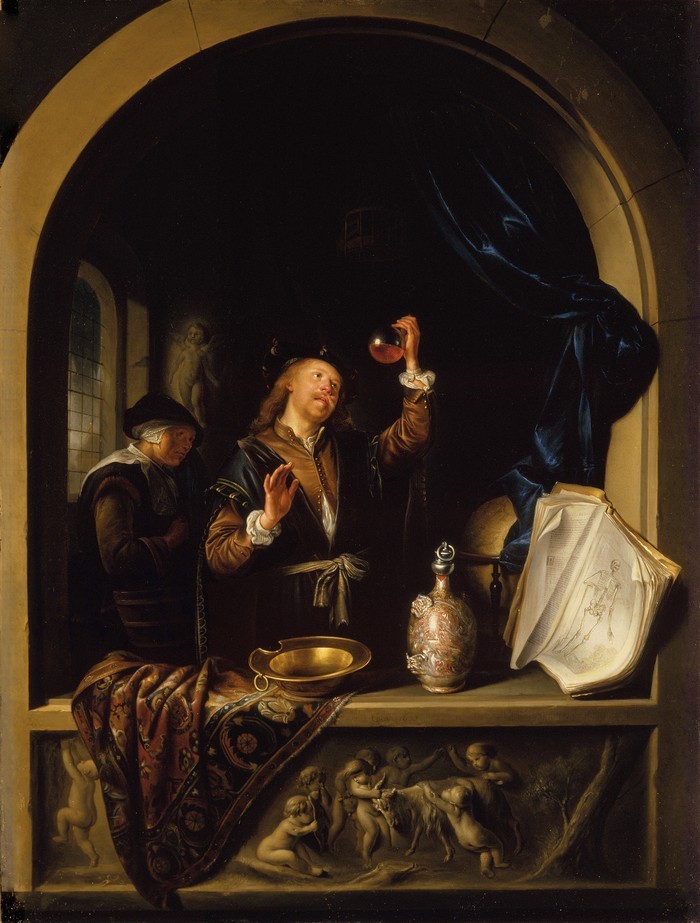
Trove
Recounting the untold stories behind some of the works in the exhibition Treasury: A Generous Legacy, curator Ken Hall also underlines the value of art philanthropy.
Exhibition
Treasury: A Generous Legacy
Stunning proof of the impact of generosity on the Christchurch collection.
Notes
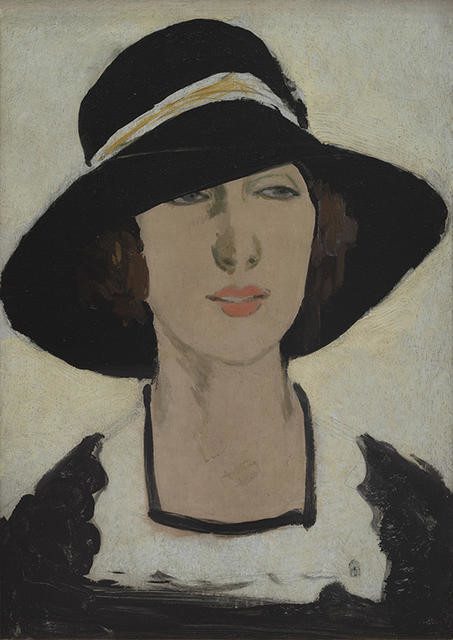
Study (Woman in a wide black hat) by Raymond McIntyre
This article first appeared as 'The Muse' in The Press on 25 August 2015.
Collection

John Gully Lake Wakatipu
In 1877, John Gully retired from his role as chief draughtsman in the Nelson Survey Office and took a month-long sketching tour of Wanaka, Milford Sound, Wakatipu and Manapouri. A year later, when he exhibited his new watercolours, he was commended by the Nelson Evening Mail for “two large watercolour paintings, the latest, and, to our mind, the best of the many that have been produced from the studio of that now celebrated artist... These represented Milford Sound and Lake Wakatipu… two nobler pictures it would be difficult to find.”
(Our Collection: 19th and 20th Century New Zealand Art, 2018)
Commentary

The wisdom of crowds
In recent years, crowdfunding and crowdsourcing have become big news in the arts. By providing a funding model that enables would-be-investors to become involved in the production of new works, they have altered traditional models of patronage. Musicians, designers, dancers and visual artists are inviting the public to finance their projects via the internet. The public are also being asked to provide wealth in the form of cultural capital through crowdsourcing projects. The Gallery has been involved in two online crowdfunding ventures – a project with a public art focus around our 10th birthday celebrations, and the purchase of a major sculpture for the city. But, although these projects have been made possible by the internet, the concept behind the funding model is certainly not new. The rise of online crowdfunding platforms also raises important questions about the role of the state in the funding and generation of artwork, and the democratisation of tastemaking. How are models of supply and demand affected? Does the freedom from more traditional funding models allow greater innovation? Do 'serious' artists even ask for money? It's a big topic, and one that is undoubtedly shaping up in PhD theses around the world already. Bulletin asked a few commentators for their thoughts on the matter.
Notes

Still life with flowers in a basket by Pieter Hardimé
This article first appeared as 'Allegory of life's beauty, brevity and fragility' in The Press on 15 August 2014.
Collection
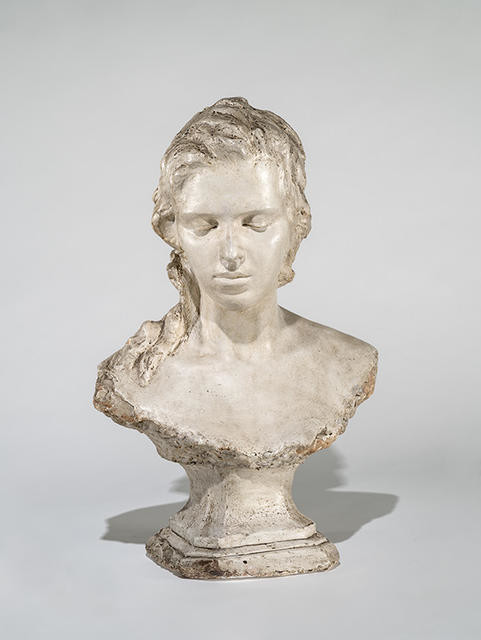
Elizabeth Kelly Laura
Elizabeth Kelly (née Abbott) made this sculptural portrait bust while at the Canterbury College School of Art, where she studied from 1891–1901. She won regular prizes for her modelling from life, including at the 1906–07 Christchurch International Exhibition. Kelly later became one of New Zealand’s leading society portrait painters, in the 1930s showing her work in exhibitions in London, Edinburgh and Paris.
Laura was modelled on the artist’s younger sister, Laura Maude Cox (née Abbott, 1884–1957). One of the earliest sculptures in the collection by a New Zealand born artist, it is a recent gift to the city from Margaret Abbott, a great-niece of the two sisters.
(Treasury: A Generous Legacy, 18 December 2015 – 27 November 2016)
Collection

Petrus van der Velden Mountain Stream, Otira Gorge
The Rotterdam-born Petrus van der Velden arrived in New Zealand in 1890. Following his first visit to Otira Gorge in January 1891, he became engrossed with this subject, and painted its powerful, surging torrents many times over the next two years.
This painting was purchased by Gilbert Anderson, a leader in New Zealand’s frozen meat industry, also involved with the Canterbury Society of Arts. Anderson sold it to the Society in 1912; it was purchased from them in 1996 through the Community Trust and Christchurch Art Gallery Trust.
(Treasury: A Generous Legacy, 18 December 2015 – 27 November 2016)
Notes

Untitled by Meindert Hobbema
This article first appeared as 'Dutch treat' in The Press on 12 April 2013.
Collection

Pieter Hardimé Still Life with Flowers in a Basket
As well as being enjoyed for their superb decorative qualities, Dutch still life paintings were intended to be reminders of the beauty, brevity and fragility of life. An arrangement of tulips, anemone, nicotiana, jonquils, morning glory and oriental poppies, this work is attributed to the Antwerp-born Flemish painter Pieter Hardimé, who lived at The Hague from 1697.
The painting arrived from Windsor, England as an unexpected and welcome gift, shortly after the 2011 earthquakes. It was given in memory of Kathleen Muriel Whiteley (1904–1949), who had historical family ties to Christchurch, from the estate of her husband Albert, whom she married two years before her death in 1949.
(Treasury: A Generous Legacy, 18 December 2015 – 27 November 2016)
Article

The East India Company man: Brigadier-General Alexander Walker
Getting to know people can take time. While preparing for a future exhibition of early portraits from the collection, I'm becoming acquainted with Alexander Walker, and finding him a rewarding subject. Painted in 1819 by the leading Scottish portraitist of his day, Sir Henry Raeburn, Walker's portrait is wrought with Raeburn's characteristic blend of painterly vigour and attentive care and conveys the impression of a well-captured likeness.
Notes

Angels and Aristocrats
Blair Jackson and I attended the opening of Angels & Aristocrats at Dunedin Public Art Gallery on Friday 27 April. It's spectacular.
Notes
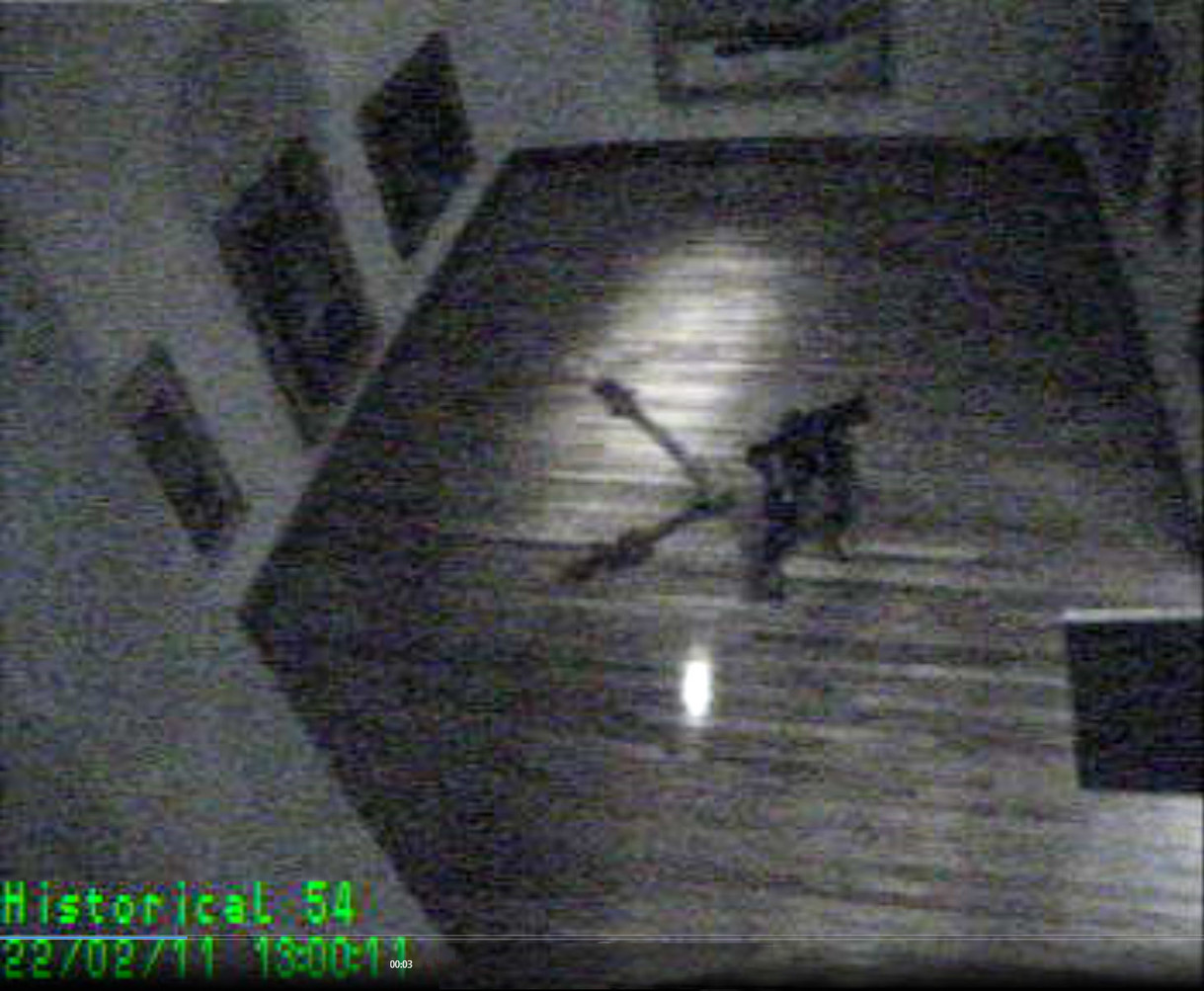
Taking Stock
It's hard to believe, but only eighteen collection works were damaged as a result of all earthquakes, with fourteen damaged on the 22 February 2011.
Collection

Thomas Benjamin Kennington Relaxation
Thomas Benjamin Kennington’s focus as an artist was in the sympathetic depiction of the everyday reality of the poor and working classes. Born in Grimsby, a seaport on England's east coast, he studied art in Liverpool, London and Paris, and from 1880 exhibited annually at the Royal Academy, where this naturalistic workroom scene was shown in 1908.
Relaxation was exhibited at the 1911 International Exposition of Art in Rome and at the 1913 New Zealand Academy of Fine Arts exhibiton in Wellington. By 1920 it was in the hands of newspaper proprietor Robert Bell. Bell was president of the Canterbury Society of Arts from 1925–26, and bequeathed ten paintings to the gallery. (Treasury: A Generous Legacy, 18 December 2015 – 27 November 2016)
Collection
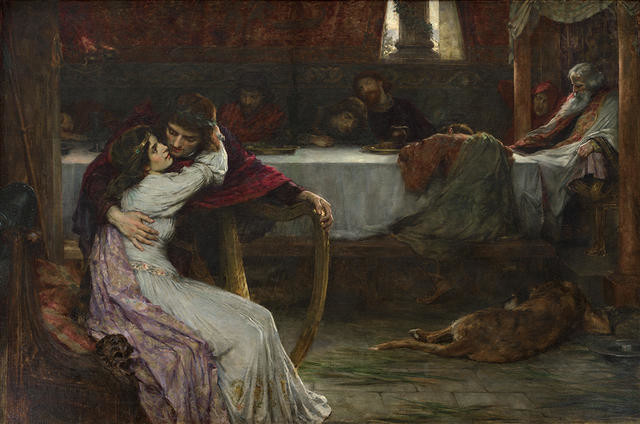
George Sheridan Knowles Glasgerion
Treading a path well established in the 1850s by the Pre-Raphaelites, George Sheridan Knowles’s Glasgerion takes its direction from the tragic medieval romance in a lyric narrative of the same name. It was one of 305 English and Scottish popular ballads collected by Francis James Child and published between 1882 and 1898. Sheridan Knowles was among many late Victorian illustrators and painters inspired by the ballads. His large-scale depiction of the eager, soon-to-be betrayed lovers was widely admired when hung on the walls of the Royal Academy in 1897.
Glasgerion was one of six paintings brought to Christchurch from London in 1903 by the Canterbury Society of Arts, which set about raising funds to buy them. This was the first painting purchased, through a gift by local politician and businessman, John Thomas Peacock.
(The Moon and the Manor House, 12 November 2021 – 1 May 2022)
Collection
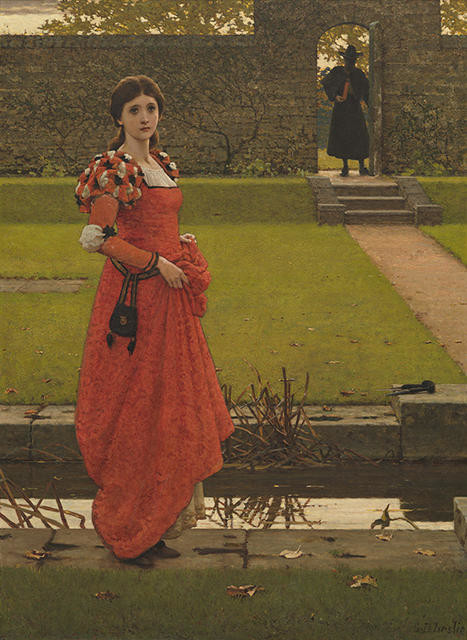
George Dunlop Leslie In the Wizard’s Garden
George Dunlop Leslie’s ‘In the Wizard’s Garden’ was exhibited at the Royal Academy in London in 1904. It reflects the Victorian- and Edwardian-era taste for historical and literary themes, often interpreted as an escapist response to the uncertainties and pressures of the industrial age. The painting depicts a young medieval noblewoman seeking the guidance of a wizard to discover the secrets of the future. The theme is based on Nathaniel Hawthorne’s ‘Rappaccini’s Daughter’, a macabre tale set in a garden filled with poisonous plants. Leslie’s garden in Wallingford, Oxfordshire, served as the inspiration for the painting’s English setting. The painting was gifted to the Canterbury Society of Arts by Wolf Harris, a former Dunedin merchant and friend to many leading British artists.
Ship Nails and Tail Feathers, 10 June – 22 October 2023
Collection
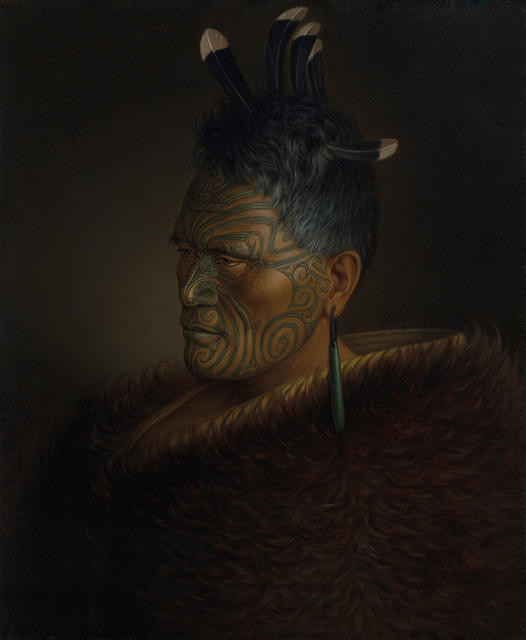
Gottfried Lindauer King Tāwhiao Tūkāroto Matutaera Pōtatau Te Wherowhero (Ngāti Mahuta, Tainui)
“Ki te kotahi te kākaho ka whati, ki te kāpuia, e kore e whati.” —King Tāwhiao [If there is but one toetoe stem it will break, but if they are together in a bundle they will never break.] While in Sydney in 1884, en route to England, King Tāwhiao had his photograph taken by Henry King. Vienna-trained, Bohemia-born painter Gottfried Lindauer obtained a copy in Aotearoa New Zealand and that became the source for this portrait.Tāwhiao’s kaupapa (intention) was to meet Queen Victoria, gain recognition of the Treaty of Waitangi, and redress the injustice of vast confiscations of Māori land – he was blocked, however, from seeing her.
(Te Wheke, 2020)
Collection
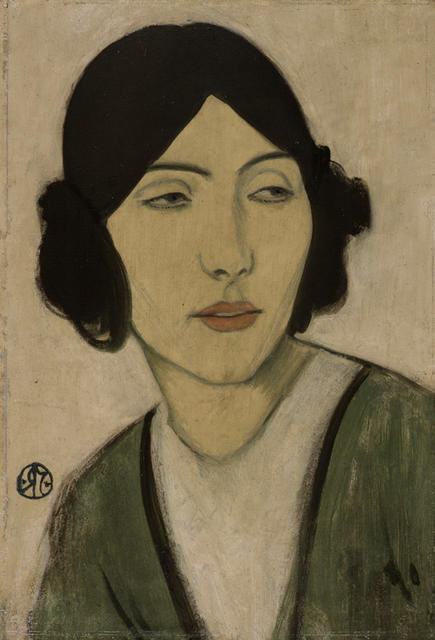
Raymond McIntyre Ruth
In 1911, two years after arriving in London, Raymond McIntyre began his long association with the Goupil Gallery, the city’s leading international contemporary art dealer, and exhibited for the first time with the prestigious New English Art Club. McIntyre built his reputation on small, pared-back landscapes and stylised heads depicting young women. The influence of Japanese woodblock prints is evident, as is the work of William Nicholson, from whom he briefly took lessons. McIntyre became an established figure in London art circles, thanks also to his role as art critic for the Architectural Review.
(The Moon and the Manor House, 12 November 2021 – 1 May 2022)
Collection

Raymond McIntyre Study (Woman in a Wide Black Hat)
In 1911, two years after arriving in London, Raymond McIntyre began his long association with the Goupil Gallery, the city’s leading international contemporary art dealer, and exhibited for the first time with the prestigious New English Art Club. McIntyre built his reputation on small, pared-back landscapes and stylised heads depicting young women. The influence of Japanese woodblock prints is evident, as is the work of William Nicholson, from whom he briefly took lessons. McIntyre became an established figure in London art circles, thanks also to his role as art critic for the Architectural Review.
(The Moon and the Manor House, 12 November 2021 – 1 May 2022)
Collection
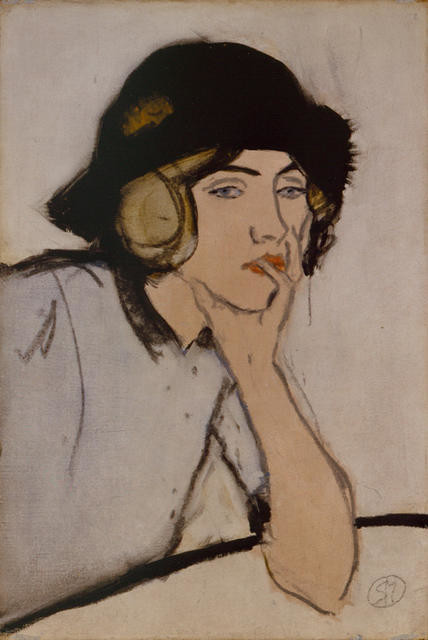
Raymond McIntyre Suzette
In 1911, two years after arriving in London, Raymond McIntyre began his long association with the Goupil Gallery, the city’s leading international contemporary art dealer, and exhibited for the first time with the prestigious New English Art Club. McIntyre built his reputation on small, pared-back landscapes and stylised heads depicting young women. The influence of Japanese woodblock prints is evident, as is the work of William Nicholson, from whom he briefly took lessons. McIntyre became an established figure in London art circles, thanks also to his role as art critic for the Architectural Review.
(The Moon and the Manor House, 12 November 2021 – 1 May 2022)
Collection

Artist Unknown Nathaniel Webb, Esq., of Roundhill Grange, Charlton Musgrove, Somerset
Nathaniel Webb, the subject of this striking 300-year-old portrait, was a Bristol merchant who – like many of his peers in this period – is known to have made a vast fortune through West Indies sugar and slavery.
Webb’s portrait was donated in 2007 by a direct descendant, in honour of her father John Jekyll Cuddon, a respected Christchurch chartered accountant. The painting came to New Zealand with Henry Joseph C. Jekyll, who immigrated to Canterbury in 1862, and in 1880 purchased a large parcel of farmland beyond the edges of Christchurch, naming it Dallington after an old family estate.
(Treasury: A Generous Legacy, 18 December 2015 – 27 November 2016)
Collection

Jacopo Amigoni Bacchus and Ariadne
Naples-born Jacopo Amigoni, a leader in the Venetian Rococo style, spent over thirty years employed in the royal courts of Europe, in Munich, London, Venice and Madrid. Inspired by classical mythology, he painted this sumptuous scene during a profitable eleven-year stretch in London, where its spectacular hand-carved ‘Carlo Maratta’ style frame was also made.
(Out of Time, 23 September 2023 – 28 April 2024)
Collection
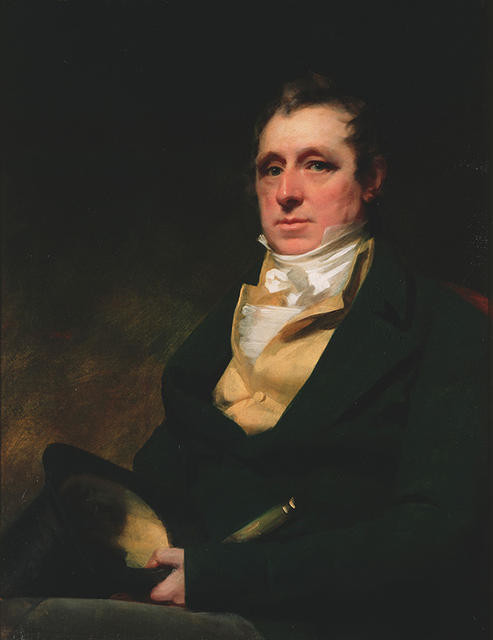
Sir Henry Raeburn Brigadier-General Alexander Walker of Bowland
The 55-year-old Alexander Walker (1764–1831) and his wife Barbara (née Montgomery, 1770–1831) commissioned Scotland’s leading portraitist, Henry Raeburn, to paint their portraits in 1819. They had married eight years earlier; shortly after Alexander’s retirement from over thirty years’ service with the East India Company – mostly in India – and had two young sons. Alexander had one final Company role before him, that of Governor of St. Helena from 1823–28.
Two of their grandsons, William Campbell Walker and Alexander John Walker, immigrated to New Zealand in 1862 to farm in Canterbury; William later became Minister of Education. These impressive ancestral portraits were presented by descendants in 1984.
(Treasury: A Generous Legacy, 18 December 2015 – 27 November 2016)
Collection
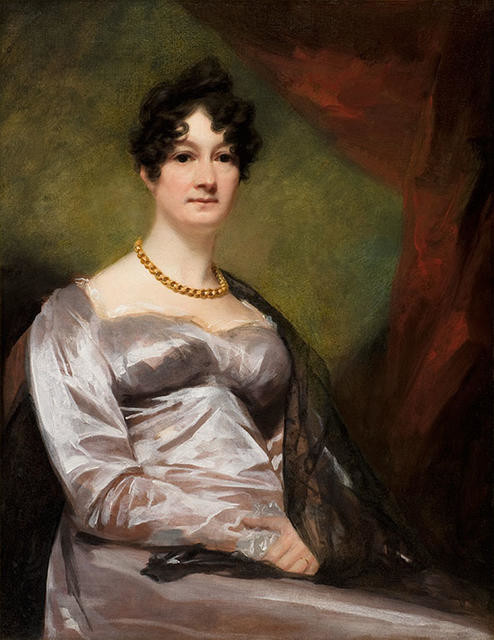
Sir Henry Raeburn Mrs Barbara Walker of Bowland
The 55-year-old Alexander Walker (1764–1831) and his wife Barbara (née Montgomery, 1770–1831) commissioned Scotland’s leading portraitist, Henry Raeburn, to paint their portraits in 1819. They had married eight years earlier; shortly after Alexander’s retirement from over thirty years’ service with the East India Company – mostly in India – and had two young sons. Alexander had one final Company role before him, that of Governor of St. Helena from 1823–28.
Two of their grandsons, William Campbell Walker and Alexander John Walker, immigrated to New Zealand in 1862 to farm in Canterbury; William later became Minister of Education. These impressive ancestral portraits were presented by descendants in 1984.
(Treasury: A Generous Legacy, 18 December 2015 – 27 November 2016)
Collection
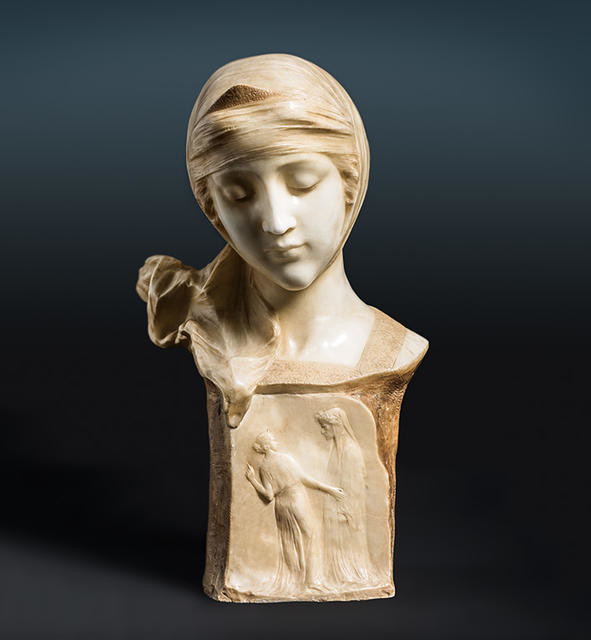
U Biagini Dante’s Beatrice
Previously attributed to the Rome-based sculptor Alfredo Biagini, Dante’s Beatrice is now recognised as the work of a lesser-known but nevertheless highly accomplished artist U. Biagini working in Florence in the late nineteenth and early twentieth century. Representing Beatrice, who captured the heart of the thirteenth-century Italian poet Dante Alighieri, it is a fine example of the Florentine sculptor’s idealised marble busts.
Dante’s Beatrice was given to the city through the bequest of the retired Christchurch merchant and importer John Alexander Redpath (1875–1975).
(Treasury: A Generous Legacy, 18 December 2015 – 27 November 2016)
Collection
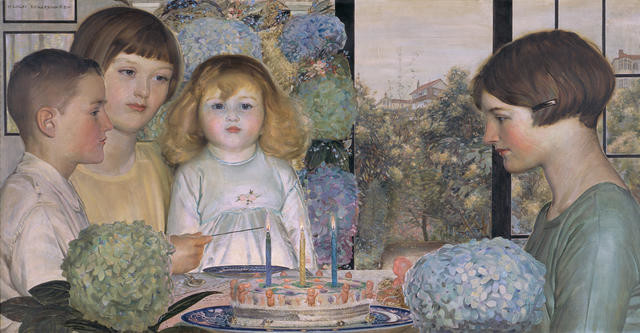
Harry Linley Richardson Cynthia’s Birthday
Harry Linley Richardson began painting Cynthia’s Birthday in Karori, Wellington in December 1926. When purchased for Christchurch’s intended new art gallery in 1928, it attracted much criticism, largely for the children’s doll-like immobility. “Where is the joyful spirit of a birthday party? Why, such dolefulness?” wrote “Disgusted Ratepayer” to the Press, also discerning “no concentration on the matter at hand, namely, the lighting of the candle.”While others defended the selection, the painter himself had no comeback. London-born Richardson had arrived in New Zealand to teach at Wellington Technical College in 1908, and was a painter with a background in illustration and design, influences both evident in this work. Looking back rather than forward, he also admired the work of mid-Victorian Pre-Raphaelite painters such as John Everett Millais, whose devotion to realism with decorative effect and melancholic tone Cynthia’s Birthday certainly suggests.The work’s solemnity also makes it difficult perhaps not to consider the demands made on sitters, even the most pliable – these were the artist’s children – and the inherent tensions of artist-model relationships.
(Persistent encounters, March 2020)
Collection
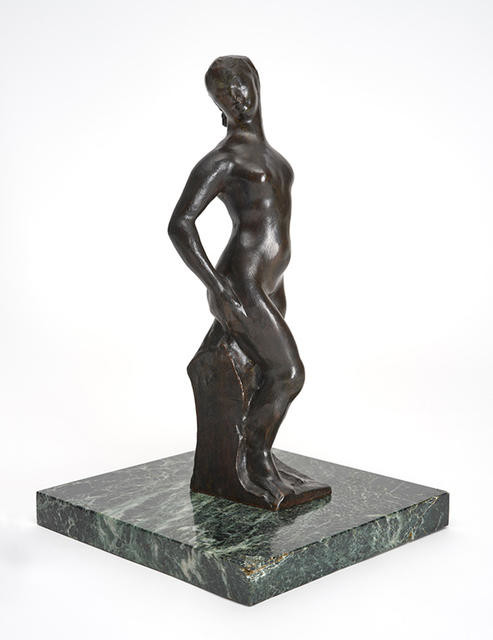
Auguste Rodin Psyche
Psyche, in Greek mythology, was a mortal princess whose beauty attracted the attention of Eros, the god of love, and the jealous anger of his mother Aphrodite. The renowned Parisian sculptor Auguste Rodin worked on variations on the theme of Psyche between 1886 and 1905. This bronze is a later casting, produced by the Musée Rodin at a foundry in Paris in 1961.
Psyche was purchased by the New Zealand Government in 1962 through a fund established to strengthen learning and cultural relations between New Zealand and France. After being exhibited in Christchurch in 1963, this city became the sculpture’s permanent home.
(Treasury: A Generous Legacy, 18 December 2015 – 27 November 2016)
Collection
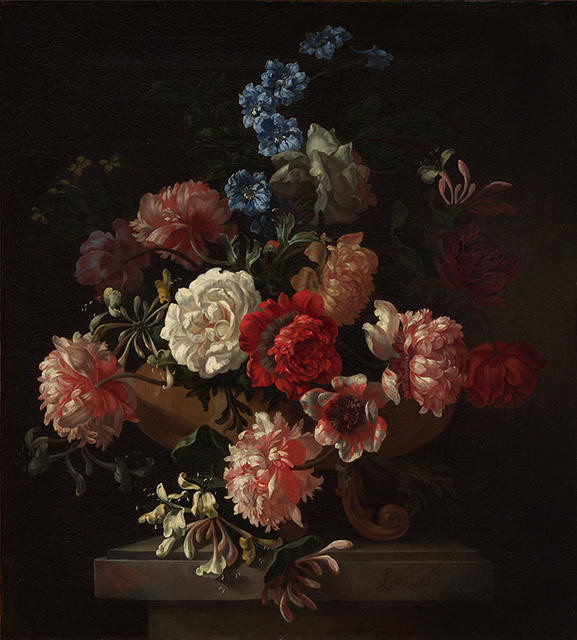
Jan Frans van Son Flowers in a vase
The Flemish artist Jan Frans van Son came from an artistic family; his father, Joris van Son, was also a respected painter. During the sixteenth century the demand for artists to paint flower subjects – particularly rare and exotic blooms – mirrored the increased enthusiasm for the cultivation of flowers in Holland. By the seventeenth century, still-life flower painting had become a major genre in Dutch painting, and it was at this that van Son excelled. He relocated to England as a young man around 1675 where he established himself as a highly successful painter renowned for his flower paintings.
(New Dawn Fades, November 2018)
Collection
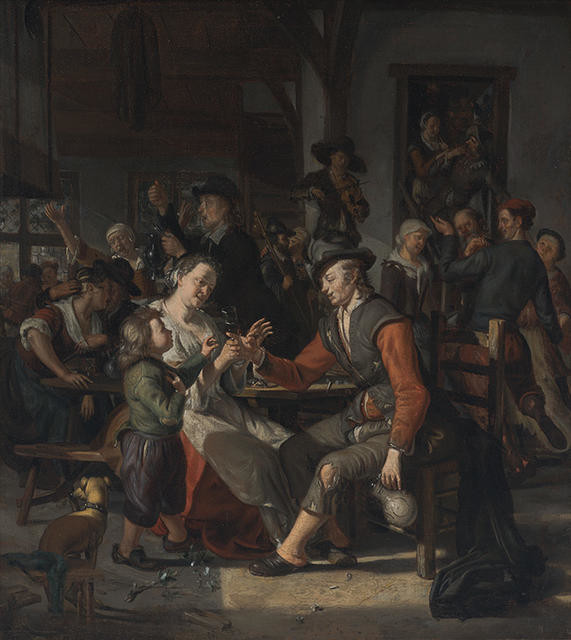
Matthijs Naiveu Scene in a Tavern
Matthijs Naiveu, like his better-known teacher Gerrit Dou, trained initially as a glass painter. Naiveu studied under Dou in Leiden from 1667–69 and advanced his career after moving to Amsterdam in 1678. This disorderly tavern scene perhaps carries an autobiographical thread – Naiveu’s father had been a wine merchant and innkeeper.
(Out of Time, 23 September 2023 – 28 April 2024)
Collection
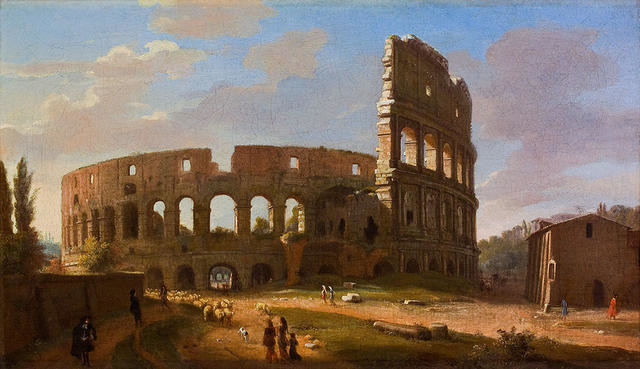
Gaspar van Wittel The Colosseum seen from the Southeast
Dutch-born Gaspar van Wittel moved to Rome at about twenty-two in 1674 and spent the rest of his life in Italy. Known there as Vanvitelli, he became pivotal in the development of the genre of painting known as veduta, topographical scenes created as high-quality mementoes for visitors to Italy on ‘The Grand Tour’.
(Out of Time, 23 September 2023 – 28 April 2024)
Gaspar van Wittel is also known by the italianised version of his name, Vanvitelli
Collection
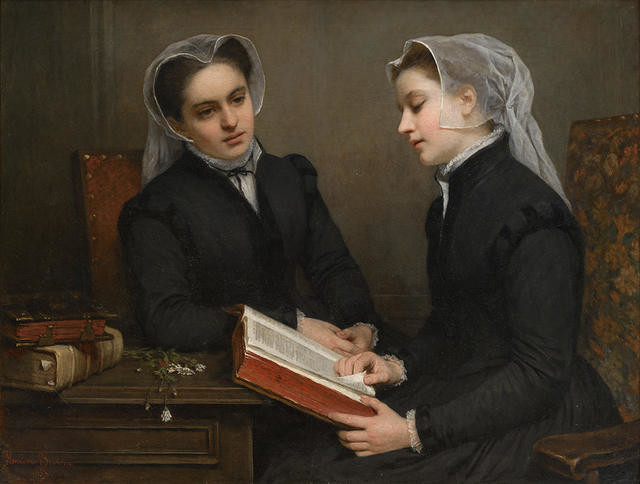
Henriette Browne La Lecture de la Bible
The French artist Henriette Browne excelled at painting highly realist, representational narrative paintings and La Lecture de la Bible is one of her finest. Browne produced several portraits of religious devotees and the two young women in this painting are thought to be novices studying to enter a religious order. They are clearly virtuous – their austere black garments suggest a puritan character and the painting is also known as The Puritans. The withered flowers on the table are the most obvious narrative element in the painting, these are a vanitas symbol for the passing of time and the loss of youth. La Lecture de la Bible was first owned by Empress Eugénie, the wife of Napoléon III, and was presented to the Gallery by its major benefactor, Robert McDougall.
(New Dawn Fades, November 2018)
First exhibited at the Paris Salon in 1857 with the title 'Les Puritaines', this painting has for many years also been known as 'La Lecture de la Bible'.
Collection
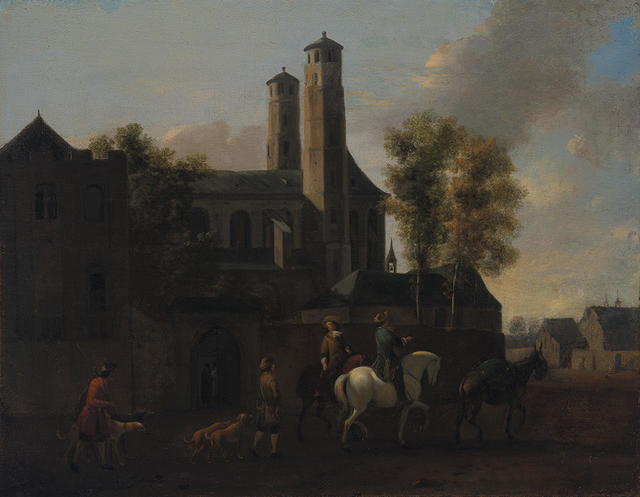
Gerrit Adriaenszoon Berckheyde A View in Cologne with St. Gereon's Basilica
Gerrit Berckheyde’s major contribution to Dutch painting was as a champion of the cityscape, a new genre that developed from the mid 1600s. Haarlem-based Berckheyde began making paintings of Cologne (Köln) in about 1670, from sketches made in Germany in the 1650s. Several works featured St Gereon’s Basilica, a Romanesque church completed in the early thirteenth century.
(Out of Time, 23 September 2023 – 28 April 2024)
Collection

Gerrit Dou The Physician
Gerrit Dou was Rembrandt van Rijn’s earliest and most successful student, and became highly sought after by European royalty and aristocratic patrons for his captivating, highly detailed works. His paintings were packed with intriguing elements waiting to be read. Here, a physician based on Dou himself carefully analyses a jar of urine for a pregnancy test.
(Out of Time, 23 September 2023 – 28 April 2024)
Collection
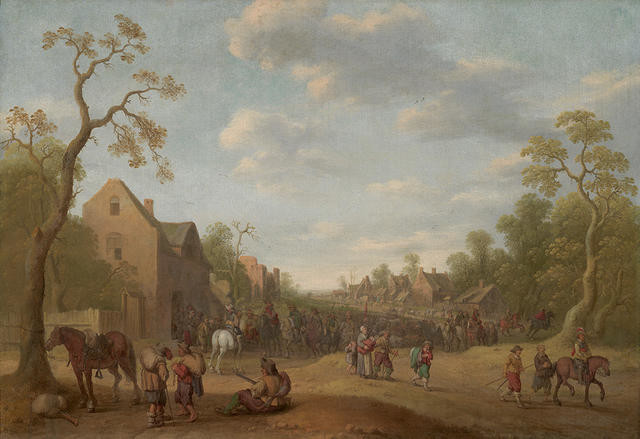
Joost Cornelisz Droochsloot Soldiers in a Village
Between 1618 and 1648, Europe was thrown into turmoil by the Thirty Years’ War – a bitter conflict that raged between Catholic and Protestant states. It was renowned for the vicious fighting often brought about by the large mercenary armies employed on both sides. Here, Droochsloot depicts the confiscations and pillaging by mercenary soldiers as they drive Dutch villagers from their homes.
(New Dawn Fades, November 2018)
Collection

Alfred Drury The Age of innocence
Alfred Drury modelled this sculptural bust after a friend’s daughter, and made numerous variations of it between 1897 and 1918. Most were cast in bronze, but some were carved in white marble. The Age of Innocence was first shown in Aotearoa New Zealand in 1903 and 1904 when Drury was completing a massive commemorative statue of Queen Victoria, commissioned for Wellington and unveiled in 1905. This version was purchased by the Canterbury Society of Arts at the 1906–07 exhibition, and is seen as reflecting the goals of the British New Sculpture movement, whose followers sought greater naturalism and symbolic qualities than found in the prevailing neoclassical approach of the time.
(Ship Nails and Tail Feathers, 10 June – 22 October 2023)
Collection
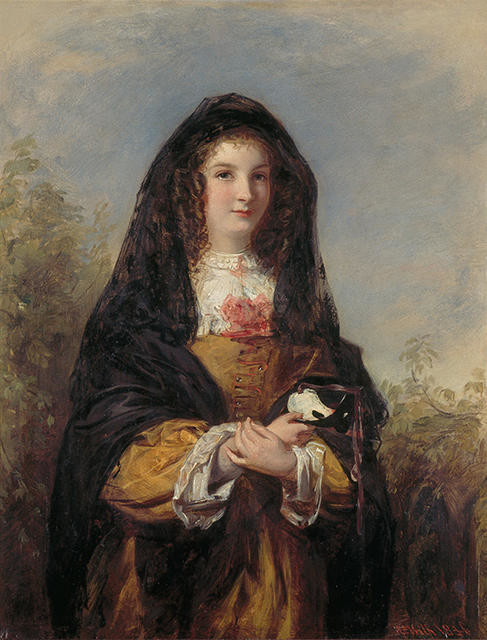
William Powell Frith Girl with a Mask
Although apparently portraying a refined Venetian lady – a young woman with carnival mask, black veil and shawl – this work was painted not in Italy, but England. Yorkshire-born William Frith, who became extremely well-known for his large, densely populated panoramas of contemporary English life, also painted small costume studies early in his career, often modelled on literary figures. Frith’s model in this work, painted in 1846, strongly resembles his wife Isabelle (née Baker), whom he married in York in June 1845; Isabelle sat for him several times. Isabelle Frith became a close friend and confidante of Catherine Dickens, wife of author Charles, who (although a friend of her husband’s) she later banned from entering their London home; this following the 1858 breakup of the Dickens’ marriage. The Frith marriage was also ‘troubled’: Isabelle had 12 children to William from 1846–60; his mistress Mary Alford had six more to him from 1855. (He married Mary in 1881, a year after the death of Isabelle.)
(The Weight of Sunlight, 16 September 2017 - 16 September 2018)
Collection

Charles Frederick Goldie Ina te Papatahi, a Ngāpuhi Chieftainess (Te Ngahengahe, Ngāpuhi)
Ina te Papatahi lived at the Waipapa Māori hostel in Mechanics Bay, Tāmakimakaurau / Auckland, not far from Charles Goldie’s Hobson Street studio. She sat for him many times, the first time in 1902. The niece of prominent Ngāpuhi rangatira (chiefs) Eruera Maihi Patuone and Tāmati Waka Nene, both signatories of the 1840 Treaty of Waitangi, she was well-connected and introduced Goldie to many other Māori who agreed to sit for him. Ina te Papatahi was later remembered by Goldie’s friend, the writer and historian James Cowan, for her “very likeable nature”, “keen sense of humour” and the “great interest [she took] in the painting of her portrait”.
(Te Wheke, 2020)
Collection

Gertrude Demain Hammond A Reading from Plato
Gertrude Demain Hammond was a prolific book illustrator whose formal art training began in 1879 at the Lambeth School of Art, alongside her sister Christiana, and continued at the Royal Academy Schools from 1885. She first exhibited in the academy’s prestigious annual summer show in 1886. In 1891 she sold a painting from the Royal Institute of Painters in Water Colours to the Empress Frederick of Germany – Queen Victoria’s eldest child, Princess Victoria – and in 1896 was elected to the institute. Gertrude and Christiana were recognised in the 1890s as Britain’s leading women illustrators. After Gertrude’s marriage in 1898, the sisters lived and worked from the same address at St Paul’s Studios, Hammersmith – a grand suite of Arts and Crafts studio apartments established as an urban artists’ colony.
A Reading from Plato was shown at the Royal Academy in 1903 before being sent to Christchurch for the 1906–07 New Zealand International Exhibition, where it was purchased by local art collector James Jamieson who, with his brother William, ran one of the country’s largest construction companies.
(The Moon and the Manor House, 12 November 2021 – 1 May 2022)
Collection
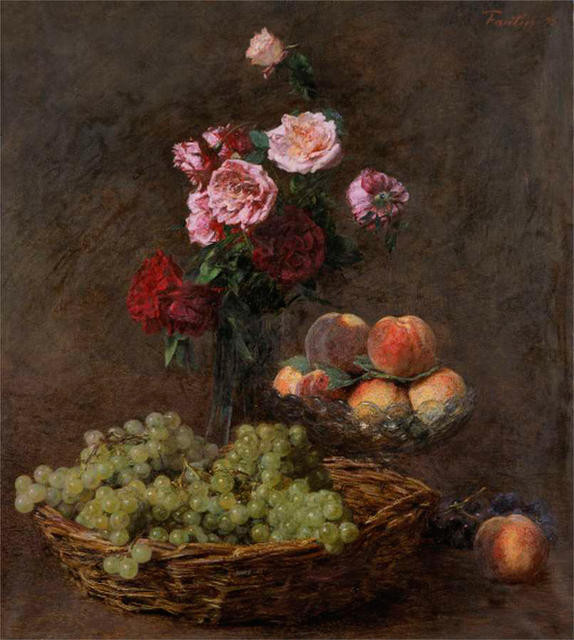
Henri Fantin-Latour Panier de Raisins
Henri Fantin-Latour’s Panier de Raisins evokes the abundance of midsummer and an atmosphere of unhurried pleasure and respite. Every June from 1878 onwards, once the clamour of the Paris Salon had subsided, Fantin-Latour and his wife Victoria (née Dubourg) closed their city apartment and headed to rural France, and a small country house in Lower Normandy, to paint until summer’s end. Henri Fantin-Latour sent the best of his new still-life paintings to his dealer in London, where they found a ready audience.Fantin-Latour produced over 800 fruit and flower paintings between 1862 and 1896, nearly all of which sold in England – the paintings for which he is most highly regarded were unknown to his countrymen. As the painter Jacques-Émile Blanche protested in 1919, “For too long, they were not found in France; Fantin was revealed to us only through rare portraits and fantasies.”
(Persistent encounters, March 2020)
Collection
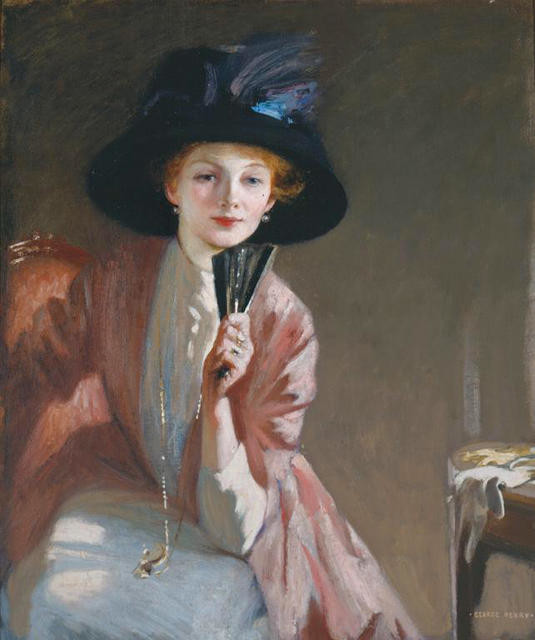
George Henry The Black Hat
In about 1901, having established a strong reputation with his painting in Scotland, the Glasgow-based George Henry relocated to London, where he began to establish a successful society portrait practice.
The Black Hat – possibly the work exhibited to acclaim as ‘La dame au chapeau noir’ at the Royal Glasgow Institute in 1904 – was one of twelve paintings selected in 1911 by the English artist Niels Lund to be purchased for the Canterbury Society of Arts. Its acquisition in 1912 was enabled through a newly agreed £50 annual subsidy from the Christchurch City Council; the society presented the painting to the city's new public gallery in 1932.
(Treasury: A Generous Legacy, 18 December 2015 – 27 November 2016)
Collection
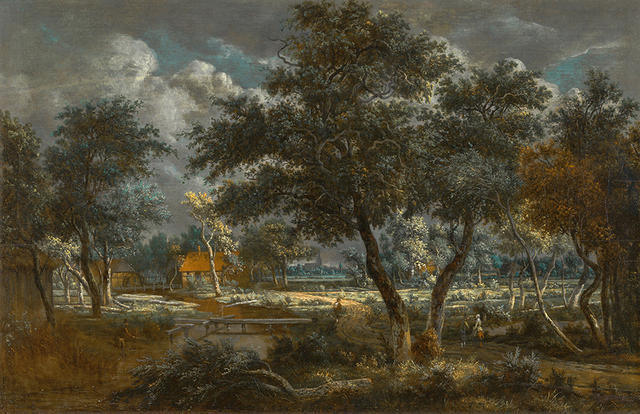
Meindert Hobbema A Wooded Landscape with Peasants on a Path and an Angler at a Stream
Although under-recognised in his own lifetime, Amsterdam-based Meindert Hobbema is now seen as one of the greatest landscape painters of the Dutch Golden Age. Hobbema’s exclusive focus on countryside relates to the extraordinary growth of Dutch cities and towns in this period, and a newfound desire for idealised depictions of rural life.
(Out of Time, 23 September 2023 – 28 April 2024)
Collection
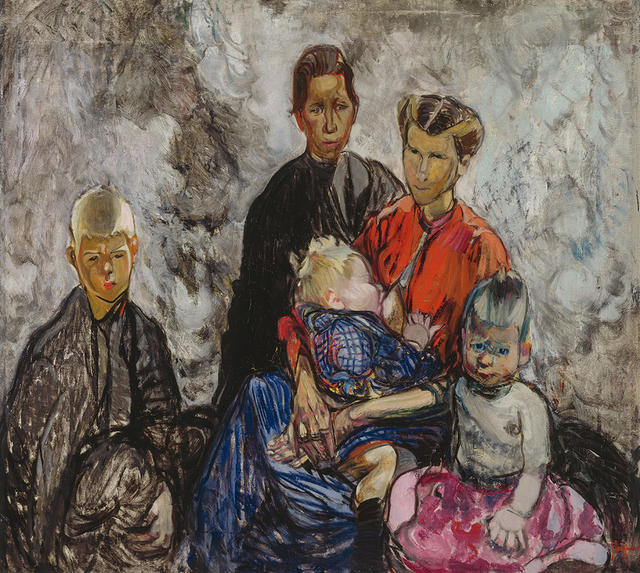
Frances Hodgkins Unshatterable (Belgian Refugees)
The Dunedin-born Frances Hodgkins was running her own watercolour painting school in Paris when World War I broke out in 1914. She relocated to St. Ives in Cornwall, where she found many displaced Belgian families also living, and painted this work in response to their wretched plight. Unshatterable, one of her first oil paintings, was exhibited in London in 1916 and purchased by the painter Sir Cedric Morris. Dr Rodney Wilson, the Gallery’s director in 1980, visited Morris, and with assistance from the National Art Collections Fund, a British art charity, successfully secured this work for the Christchurch collection.
(Treasury: A Generous Legacy, 18 December 2015 – 27 November 2016)
Collection

Frances Hodgkins Pleasure Garden
“You say in yr last [letter] that I will not tag on to Colonial life after staying away so long – you surely don’t expect & want me to settle down into a Maiden Aunt do you & throw up career & ambition & lose the precious ground I have gained – you are much too dear and unselfish for that I am sure. I am coming out merely to see you & Sis & the children, to be with you for a while & then to return to my work like any man of business. To make you happy I must be happy myself. I want to see you badly & feel I must come soon at no matter what sacrifice. But do realise Mother that it’s on this side of the world that my work and future career lie. I grieve sometimes that you do not understand this more.” – Frances Hodgkins, excerpt from a letter to her mother, Rachel Hodgkins, 1911
(Perilous: Unheard Stories from the Collection, 6 August 2022- )
Notes
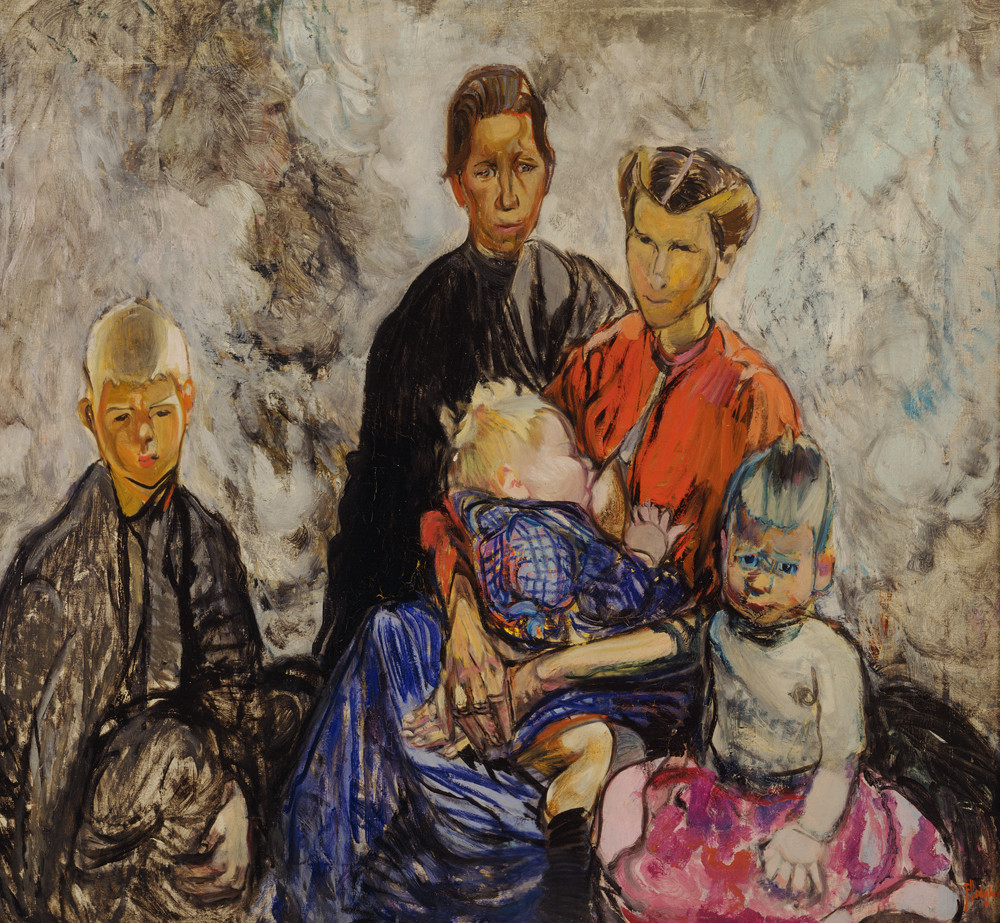
Belgian Refugees by Frances Hodgkins
This article first appeared in The Press on 28 February 2007
Belgian Refugees is one of the first oil paintings that Frances Hodgkins ever exhibited, although at the time she was already well accustomed to showing her watercolours. Working in oils and tempera on canvas, she used an experimental technique in this work that gained much from her experience with watercolour. Believed to have been first shown as Unshatterable, in October 1916 at the International Society's Autumn Exhibition in London, the choice of title would suggest a greater sense of resilience than is actually conveyed by this family group. Here only the baby is oblivious to trouble, while his nursing mother seems devoid of expression, and the older children tense with anxiety or fear. Behind the group, a gap in the swirling grey suggests the fact of a missing father, and this steam and smoke speaks of displacement, the atmospheric backdrop of a train station or the symbolic clouds of war. Within the wall of monochrome, intense colour is reserved for mother and child, who also remind of one of Hodgkins' favourite early choices of subject matter in watercolour.
